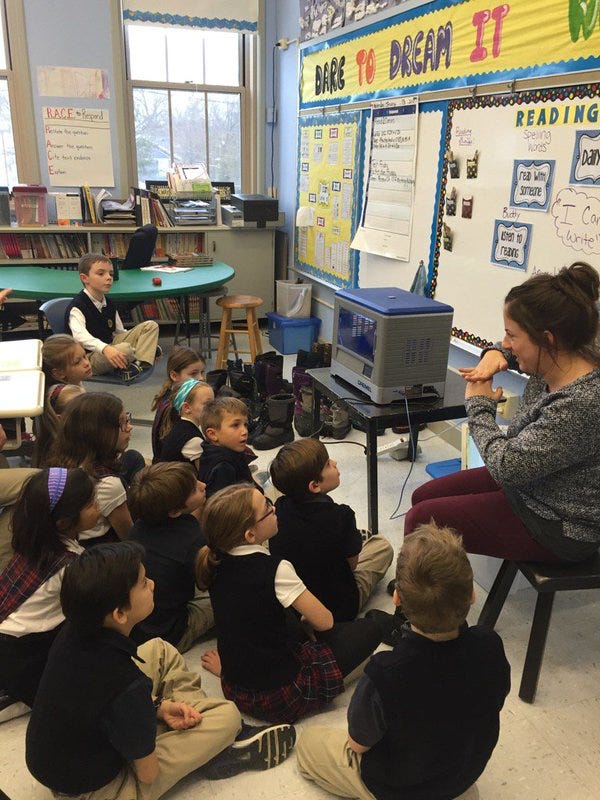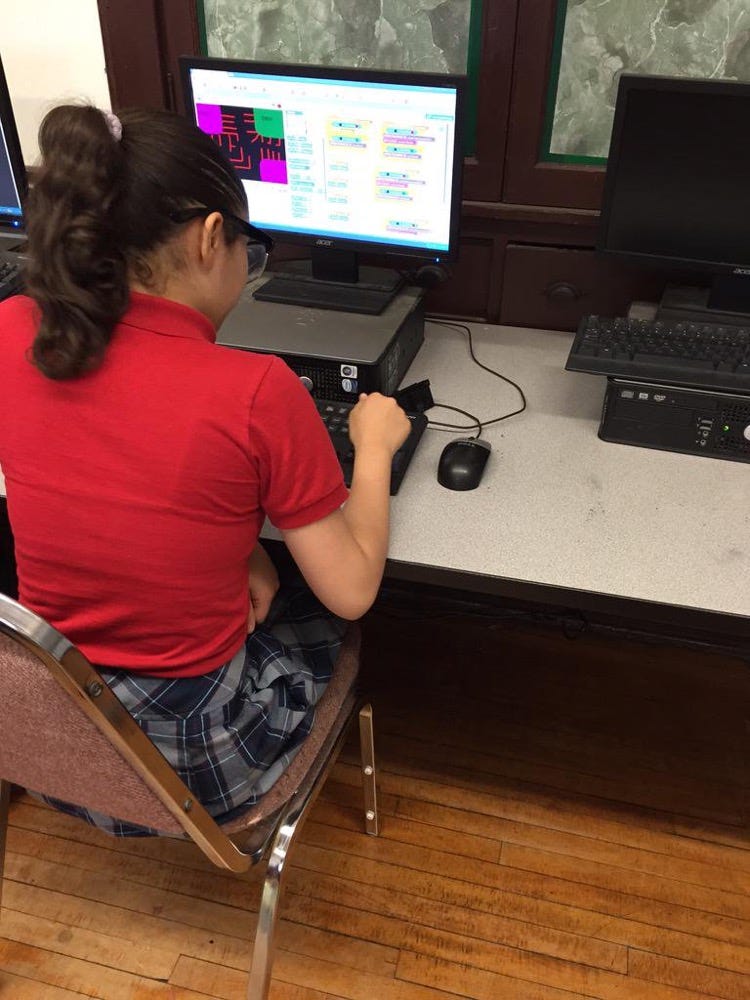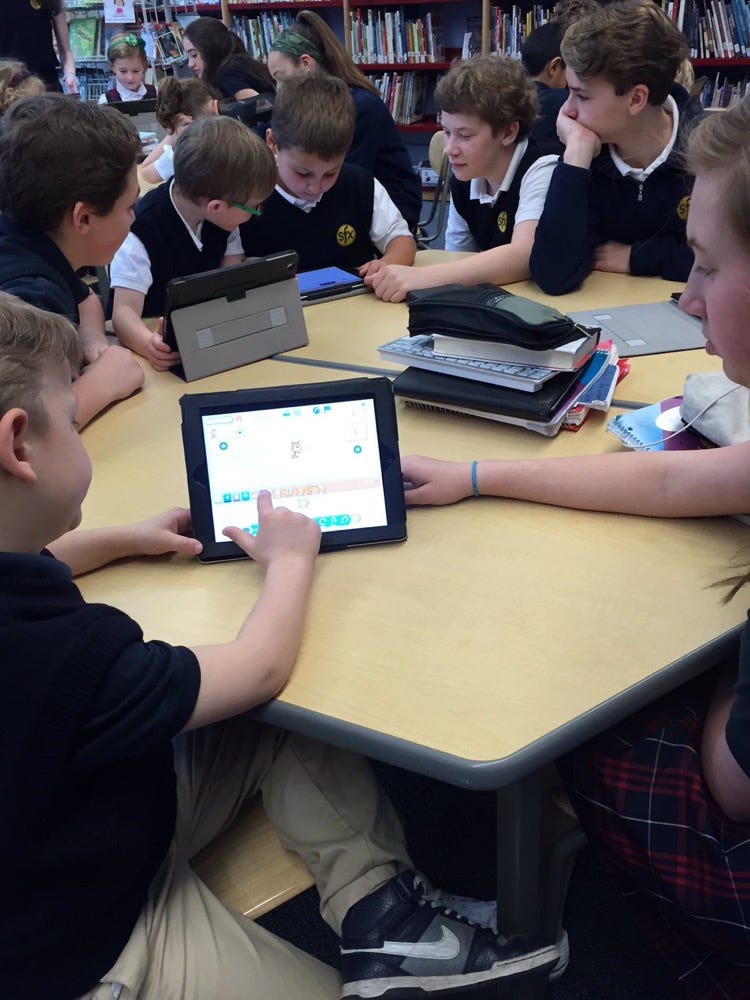Meet the Educator: Claire Pritchard
Meet the Educator: Claire Pritchard
By My Nguyen
This story was originally published on the Scratch Foundation blog.
What do music and computer programming have in common?
If you ask Claire Pritchard, she’ll tell you “resilience.”
Pritchard works a tech integration specialist in Chicago, but her career began in music education.
“One of the things I’ve learned is that if you have a basic understanding of one thing, it can be applied to almost anything. I think about some of the skills and traits I gained in music school, and I think those qualities are what’s made it easier for me to pick up new skills. The arts are designed to make you super resilient. Every time I teach myself something new — like programming — resilience enables me to keep trying until I can do it.”
While she was completing a second degree to become a reading specialist, a teacher in her program told her about a job for a part-time computer teacher and music teacher. Because much of her research focused on digital literacy and coding as a new form of literacy, Pritchard decided to take the job.

Pritchard started teaching in a traditional computer lab. Because many of the computers were outdated and could perform only limited tasks, she researched ways to make the experience more meaningful for her students.
That’s when she stumbled upon Scratch. Pritchard taught herself how to program with the blocks-based programming language, then brought it to her students.
“They were obsessed. One of my former students has cranked out more than 160 projects since I first showed her Scratch two years ago. Whenever I gave the students free time in lab, she’d sit in the back corner, log on to Scratch and work on her projects. She gained followers. People remixed her projects. She was totally into it.”
From there, Pritchard bought LEGO robotics kits and taught herself how to make the robots interact with Scratch. Within four years, she went from knowing almost nothing about technology and coding to running professional development for teachers about coding and robotics.
“After I found Scratch, it kind of opened the door for this whole idea of being a maker-teacher. It was Scratch that sparked the first love of all of this for me.”
The Scratch Foundation recently spoke to Claire Pritchard to learn more about her Scratch story and experiences in the classroom.
Who are you and what do you do?
My name is Claire Pritchard. I teach in the Chicago area. I have been — over various points of my life — a music teacher, band director, and reading specialist. My official title right now is Tech Integration Specialist.
How are you using Scratch in the classroom right now?
Right now, I primarily use Scratch to support literacy instruction — for example, retelling, original stories, and alternate endings. We do a lot with retelling using Scratch and ScratchJr for second, third, and fourth grade.
Why do you use Scratch in your classroom?
I really appreciate everything that Scratch and Mitchel Resnick have done to make my students’ lives better. Last year, I had a third grader who had a speech impediment. He wouldn’t talk in class, but he would turn out these beautiful Scratch projects with narration. Scratch has given my students a voice.

Do you have a favorite anecdote of programming with your students?
My third graders this year were a great group of kids. They were obsessed with the idea of adding “bro” to words — you know, “Broseiden, Lord of the brocean,” “brotato.” One day, we were going over some of the movement blocks in Scratch, and one of them figured out how to import an image, make it spin, and make it flash colors using the forever loop. Since the image was a picture of a potato, we decided that it had to be called “The Color-Changing, Spinning Brotato.”
The idea that a student figured out how to do all of these things on his own, then had a group of kids who wanted to learn how to do all of those things from him was a great example of the peer teaching through collaboration that Scratch lends itself to.
I run a really informal classroom, so I feel like the kids are often times more expressive and weird with me than they would be in other classes. I like that we can tap into their creativity and humor.
Do you remember the first Scratch project that you created?
I had Scratch Cat and a duck talking to each other. Have you ever heard the “Give me some ChapStick and put it on my bill” joke?
The cat goes, “A duck walks into a pharmacy,” and the duck says, “Then what do I do?” The cat says, “Wait, this is my line.” The duck says, “Oh yeah, give me some ChapStick and put it on my bill.”
Describe the process of teaching yourself how to program with Scratch.
The first time that I got the cat to move and change colors on my own was the greatest moment of my life. My husband — who is a professional programmer — was sitting next to me as I was figuring it out, laughing at me snapping blocks together to make things happen. I screamed, “Oh, my gosh! It worked!”
I have this pathological need to figure out how to make things work, so I had this great sense of accomplishment. It is really what has gotten me so into Scratch. The first time I got a character to draw with a pen tool was incredible. The first time that I programmed a light to blink [with Scratch and Arduino] was like the first time I got the Scratch Cat to move.
What do you hope your students gain from these experiences with programming?
Number one, I would like them to know that programming is not a big scary thing that you have to be some sort of super genius to do. Number two, I want them to have an appreciation for how computers work and how the technology that they interact with daily runs. I’m not expecting to turn out the next generation of engineers or computer programmers — I just want them to be cognizant. I believe that in order to be well-rounded, well-educated individuals going forward, this is going to be a really important skill for them to know.
I also want them to see programming as a new outlet for their creativity. Kids are so creative, and I don’t think we give them enough credit for that. Our educational system right now does not give kids enough opportunities for creativity.

My classroom revolves very much around community and learning together. I want my students to realize that they will have a lot of opportunities for collaboration in the future. I think that Scratch is a really good model for these collaborative opportunities they’ll encounter in the future.
You are now in a career that you probably didn’t anticipate when you were studying music. What have you learned about yourself through your experiences with Scratch?
Growing up, in high school, I was one of those high-achieving AP kids — everything had to be correct, and you had to know everything right away. One of the things I’ve learned as I’ve gotten older — and through three career changes — is that it’s okay to not be a total expert, and it’s okay to say, “Hey, let’s learn this together. Let’s figure this out together.” It’s okay to trust my students to learn with me and to say we’re all learning together.
What advice do you have for educators who want to introduce Scratch programming to their students?
My advice — and this is the advice that I give to some of my students — is that if you are unsure about it, just set it up and then start. I’ve found that it’s easier to introduce something new in small groups than it is to start a grand initiative. I believe that if you start small and spark some excitement, it is easier to devote time to build it into something scalable.

